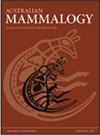通过圈养试验和实地研究,改进小型哺乳动物无线电发射机连接方法
IF 1.2
4区 生物学
Q3 ZOOLOGY
引用次数: 1
摘要
无线电追踪可用于收集有关动物运动、活动范围、行为和栖息地使用的信息。许多实地研究使用永久性尼龙电缆系带项圈将无线电发射器安装在小型啮齿动物身上,并成功收集到运动和命运数据。在科学研究的背景下,动物福利的方法优先考虑尽量减少对研究动物的不利影响。尽管在大型哺乳动物的无线电跟踪项圈中存在一系列电子激活的释放机制,但重量和尺寸的限制使这些项圈不适合小型动物(20天收集运动数据,然后在30天后分离或显示分离迹象)。实验室和田间试验确定,一种带有棉线弱连接和定制无线电发射器的电缆领带项圈适合种植围场的野生家鼠。粘接方法不能保持足够长的时间,无法获得超过几天的跟踪数据。本文章由计算机程序翻译,如有差异,请以英文原文为准。
Improving radio transmitter attachment methods for small mammals through captive trials and field studies
Radio tracking can be used to collect information about animal movement, home range, behaviour and habitat use. Many field studies have fitted radio transmitters to small rodents using permanent nylon cable tie collars and successfully collected movement and fate data. The approach to animal welfare within the context of scientific research prioritises minimising adverse effects on the research animals. Although a range of electronically activated release mechanisms exist in radio tracking collars for larger mammals, weight and size restrictions make these unsuitable for smaller animals (<30 g). Our aim was to identify a radio transmitter model and attachment method of an appropriate size and weight that would remain attached to a house mouse (Mus musculus) for >20 days to collect movement data – and then detach or show signs of detaching after 30 days. Laboratory and field trials identified that a cable tie collar with a cotton thread weak-link and customised radio transmitter was suitable for wild house mice in cropping paddocks. Glue-on methods did not stay attached for long enough to obtain more than a few days of tracking data.
求助全文
通过发布文献求助,成功后即可免费获取论文全文。
去求助
来源期刊

Australian Mammalogy
ZOOLOGY-
CiteScore
2.50
自引率
8.30%
发文量
26
期刊介绍:
Australian Mammalogy is a major journal for the publication of research in all branches of mammalogy. The journal’s emphasis is on studies relating to Australasian mammals, both native and introduced, and includes marine mammals in the Antarctic region. Subject areas include, but are not limited to: anatomy, behaviour, developmental biology, ecology, evolution, genetics, molecular biology, parasites and diseases of mammals, physiology, reproductive biology, systematics and taxonomy.
Australian Mammalogy is for professional mammalogists, research scientists, resource managers, consulting ecologists, students and amateurs interested in any aspects of the biology and management of mammals.
Australian Mammalogy began publication in 1972 and is published on behalf of the Australian Mammal Society.
 求助内容:
求助内容: 应助结果提醒方式:
应助结果提醒方式:


